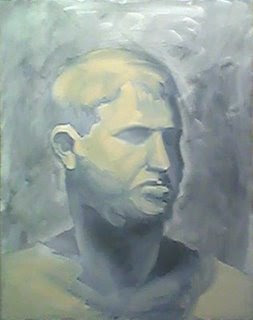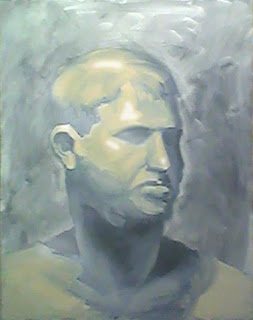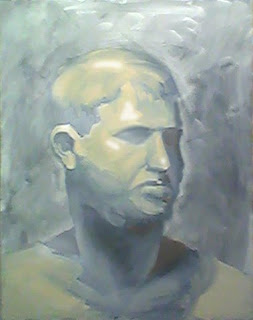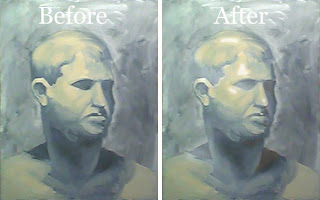"I always paint what I know and not merely what I see."
Karin Wells
I am so grateful to have permission to use a student work to critique in order to illustrate a couple of the fundamental principals of painting.
This is NOT a critique of the drawing - that is another subject. But you can see how easily the drawing will be to correct when the principals of light and shadow are correctly applied.
THE ORIGINAL STUDENT WORK:

This is the original work - a quick life study in warm and cool. The student used Payne's Grey, Raw Sienna and Titanium White.
WHEN A SHADOW FALLS ON THE LIGHT SIDE IT WILL BE LIGHTER:

This is a hard one for most people to understand so I'll try to make the steps duck-soup simple.
Each object has a shadow side and a light side.
So I added a shadow to the shadow (right) side of the forehead where there was none.
Because the light comes from the upper left, I lightened the dark shadow on the shoulder on the left...because, given the light, I didn't think it could have been a dark "cast" shadow.
IMPORTANT: When a shadow appears on the light side of an object it will appear lighter than any shadow on the shadow side of the face (as illustrated with a heavy hand above).
Accordingly, I lightened the left eyesocket and all down the light (left) side of the face and neck.
IMPORTANT: No shadow ought to dramatically disrupt the flow of light on a lighted plane. Or, the light will illuminate whatever shadow it surrounds.
WHEN LIGHT FALLS ON THE SHADOW SIDE IT WILL BE DARKER THAN ON THE LIGHT SIDE
So keeping this in mind, I darkened both the light that fell on the cheek on the shadow side of the face and the light on the lip as it entered the shadow side of the face.
The value of light and shadow areas are not equal and are determined by where they fall.
HIGHLIGHTS ARE COOL:

Highlights need to be cool. The term "warm and cool colors" are relative - often determined by what surrounds them.
The general light is always warm and the student got it correct here. However, highlights are always lighter and cooler (as added to the original pix above via Photoshop) and it is the layering of warm and cool that will create form.
IMPORTANT: It may help you to think that a highlight will reflect the white light of the sun.
CAST SHADOWS ARE WARM (you can make them colorful and hot):

Deep shadows (aka, cast shadows) are warm - and if you make them hot - they don't even have to get too dark. I added a little orange into the deep shadows above to illustrate this.
Warmth can be glazed or painted thickly. Sometime a thin (subtle) glaze of cadmium orange will breathe a little life and fresh air into a dead dark shadow.
If I were correcting this painting with real paint I would use a glaze of raw sienna to warm up these cast shadows (eyesocket, bottom of nose, and under the chin on the shadow side of the head).
LOSE AND FIND EDGES (shown above)
All the edges on this original work are "found" so I "lost" a couple of edges when I changed the light/shadow ratios to facilitate the integration of background and foreground. Adjusting the value of either the background or the foreground is a good way to "lose" an edge.
The student can correct this with a brush with a heckuva lot more finesse and subtlety than I have with my clumsy Photoshopping efforts.
BEFORE AND AFTER COMPARED:

See how much more "sculptural" this painting has become? It suddenly appears as if the drawing has been "corrected" - but it wasn't (you saw exactly what I did, eh?).
Merely following some very basic principals of light and shadow will go a long way to painting more accurately (and certainly more easily).
Painting is Duck Soup Simple when you know how.
"Knowing what you're looking at makes painting so much easier."
Karin Wells






2 comments:
You know, Karin, there are times I wonder if you post these just for me! The posts seem to always come when I'm having trouble with that very thing. I really love how simply you break everything down. Wonderful demo. Thank you
I'm glad it helped Tali.
Finding a work to critique is more useful than giving a lesson from scratch...I wish I had more of these.
Our mistakes tend to be universal - nothing is new - and it is easier to see them in someone else's work.
Lack of knowledge - not lack of talent - is what keeps most of us stuck.
Post a Comment